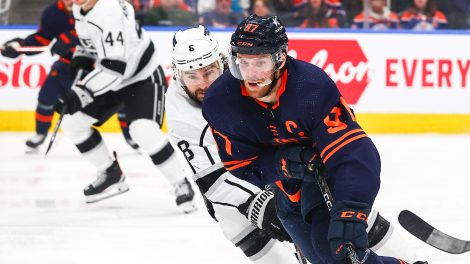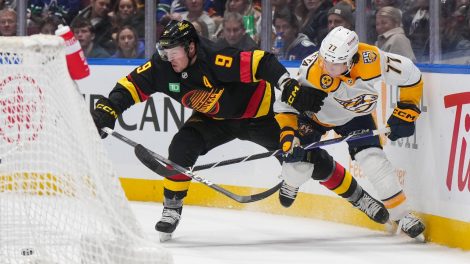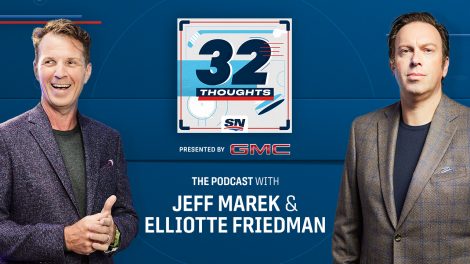It’s all but impossible to acquire an impact NHL defenceman via trade in-season. When one becomes available, it’s a major story.
Make that defenceman young and signed long-term to an extremely team-friendly contract, and we’ve entered the realm of unadulterated fantasy.
So it’s no wonder Travis Hamonic’s request for a trade to Western Canada became a massive story as soon as Elliotte Friedman reported it a week ago.
The Winnipeg Jets are a logical fit for Hamonic, who is originally from the Manitoba community of St. Malo, located roughly an hour’s drive south of Winnipeg. The Jets can even trade like-for-like with the New York Islanders, as they have three right-shot defencemen who might plausibly fill Hamonic’s role on the team.
Of those three, Tyler Myers is the logical fit.
Jacob Trouba might make sense for the Isles, but his youth and already-demonstrated ability mean that it makes little sense for Winnipeg to move him. Dustin Byfuglien might make sense, but because he’s a pending free agent he’d be a poor fit for an Islanders team that needs a long-term replacement for Hamonic should they move him.
Myers, though, fits the bill on multiple levels. He’s young, signed long-term and as close a substitute for Hamonic in the here-and-now as Islanders G.M. Garth Snow could hope for. He’s also far enough back of Hamonic as a defenceman that the Jets would legitimately be improving their blue line, and not just making a lateral move to help an opponent.
As players, Myers and Hamonic both fill the same basic niche as big, right-shot, two-way defencemen. Both play on the power-play, the penalty kill and at even-strength, with Myers getting a bigger role on the man advantage and Hamonic spending more time at five-on-five.
| 1. Selected career offensive statistics | ||||||
|---|---|---|---|---|---|---|
| Player | GP | PTS | PP TOI | PP P/60 | EV TOI | EV P/60 |
| Hamonic | 345 | 117 | 1.3 | 3.27 | 18.0 | 0.78 |
| Myers | 412 | 173 | 2.6 | 2.25 | 16.4 | 0.86 |
Myers enjoyed a hot start to his career as an offensive defenceman, scoring 48 points as a rookie. Hamonic’s start was far less spectacular, as he managed only 26 points in his first year in the league. However, while Myers has played far more power-play minutes (likely as a result), Hamonic has been the more efficient scorer. Hamonic has averaged 3.3 points/hour over his career on the power-play while Myers has averaged just 2.3.
Additionally, Myers’ numbers are inflated by his hot start; he hasn’t topped 3.0 points/hour on the power-play since 2010-11 while Hamonic scored 5.3 points/hour last year.
At even-strength, Myers has been a slightly better scorer than Hamonic, but it is close. Myers has averaged 0.86 points/hour over his career at five-on-five, while Hamonic has managed 0.78. That puts Myers 33rd among active defencemen over that period and Hamonic 52nd, putting both in the No. 2 defenceman range in terms of even-strength scoring.
Hamonic’s significantly better results on the power-play probably outweigh the small difference between the two at five-on-five, and even if they don’t, the evidence suggests that Hamonic is the superior defensive defenceman.
| 2. Selected career on-ice statistics | ||||||
|---|---|---|---|---|---|---|
| Player | EV TOI | QComp | ZS Rel. | Rel. SC | Rel. HDSC | SC |
| Hamonic | 18.0 | 17.7 | -2.0 | 0.2 | 0.9 | 49.7 |
| Myers | 16.4 | 17.6 | -2.7 | -0.5 | -0.6 | 46.4 |
At even-strength, the two play similar minutes. Hamonic plays slightly tougher competition while Myers starts slightly more shifts in the defensive zone. The gap is minimal except that Hamonic plays more minutes.
But while the way their respective coaches use these defencemen is similar, the results are wildly different.
Hamonic outperforms his team average in terms of scoring chances, and by an even wider margin in terms of high-danger scoring chances. Myers trails his team average in both counts.
Critically, Hamonic has also played for better teams. He’s outperformed the team average of a pretty competent Islanders squad the last few seasons. In contrast, Myers has underperformed the team average of a mostly terrible Buffalo Sabres team. It should be no surprise that since joining a quality Jets team, his on-ice scoring chance numbers have underperformed the club average by even more than they did in Buffalo.
The same is true in shorthanded situations. Over Myers’ career, his teams have allowed 52.5 scoring chances against per hour while he was on the ice. Over Hamonic’s career, his teams have allowed a very comparable 52.6 chances against per hour. The difference is that with Myers off the ice, the Sabres only allowed 50.5 chances/hour, while with Hamonic off the ice the Isles allowed 51.2 chances per hour. Buffalo’s penalty kill has generally been better than New York’s over these players’ respective careers, and yet their on-ice numbers are basically identical. (Side note: playing first unit on the penalty kill means more assignments against top power-play units, which may explain why both defencemen trail their team averages).
Hamonic is arguably better than Myers offensively and he’s a better defensive player at five-on-five and while killing penalties. The only real wrinkle is contract. Myers’ deal was front-loaded, and his actual annual salary over the remainder of his contract is quite low, coming in at just under $4 million per season. Hamonic’s deal was back-loaded, so he costs about $600,000 per season more on average. For a Winnipeg team with an internal budget, actual dollars matter more than cap hit and so Myers’ deal is a bigger positive for them.
That shouldn’t be definitive, though, particularly since Hamonic is under team control for one year more than Myers. More importantly, Hamonic is better than Myers in pretty much every category. This is a trade the Jets should make if at all possible, and it might be the best trade the Islanders can make, given the difficulty in finding a replacement for Hamonic in-season.









